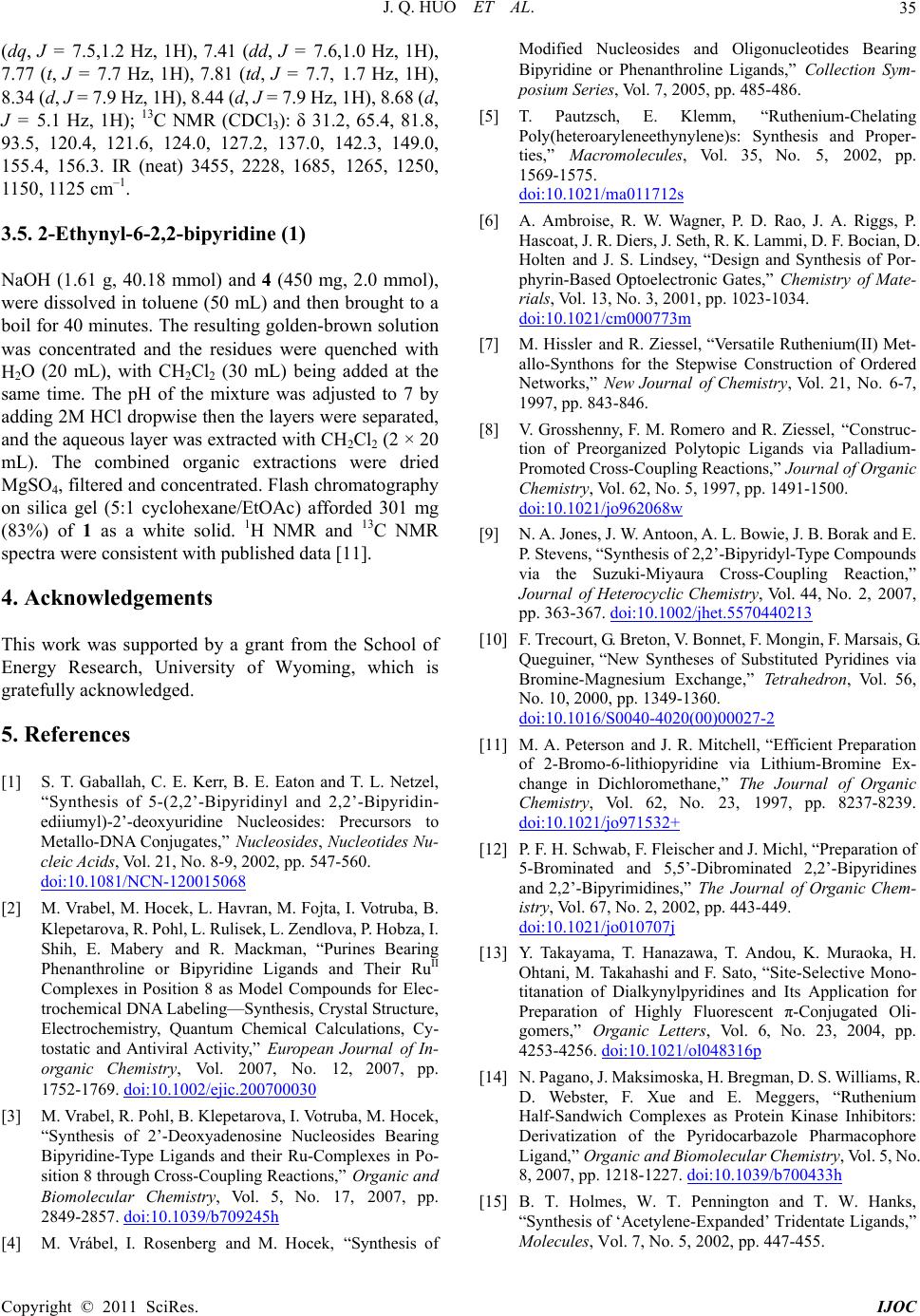
J. Q. HUO ET AL.35
(dq, J = 7.5,1.2 Hz, 1H), 7.41 (dd, J = 7.6,1.0 Hz, 1H),
7.77 (t, J = 7.7 Hz, 1H), 7.81 (td, J = 7.7, 1.7 Hz, 1H),
8.34 (d, J = 7.9 Hz, 1H), 8.44 (d, J = 7.9 Hz, 1H), 8.68 (d,
J = 5.1 Hz, 1H); 13C NMR (CDCl3): δ 31.2, 65.4, 81.8,
93.5, 120.4, 121.6, 124.0, 127.2, 137.0, 142.3, 149.0,
155.4, 156.3. IR (neat) 3455, 2228, 1685, 1265, 1250,
1150, 1125 cm–1.
3.5. 2-Ethynyl-6-2,2-bipyridine (1)
NaOH (1.61 g, 40.18 mmol) and 4 (450 mg, 2.0 mmol),
were dissolved in toluene (50 mL) and then brought to a
boil for 40 minutes. The resulting golden-brown solution
was concentrated and the residues were quenched with
H2O (20 mL), with CH2Cl2 (30 mL) being added at the
same time. The pH of the mixture was adjusted to 7 by
adding 2M HCl dropwise then the layers were separated,
and the aqueous layer was extracted with CH2Cl2 (2 × 20
mL). The combined organic extractions were dried
MgSO4, filtered and concentrated. Flash chromatography
on silica gel (5:1 cyclohexane/EtOAc) afforded 301 mg
(83%) of 1 as a white solid. 1H NMR and 13C NMR
spectra were consistent with published data [11].
4. Acknowledgements
This work was supported by a grant from the School of
Energy Research, University of Wyoming, which is
gratefully acknowledged.
5. References
[1] S. T. Gaballah, C. E. Kerr, B. E. Eaton and T. L. Netzel,
“Synthesis of 5-(2,2’-Bipyridinyl and 2,2’-Bipyridin-
ediiumyl)-2’-deoxyuridine Nucleosides: Precursors to
Metallo-DNA Conjugates,” Nucleosides, Nucleotides Nu-
cleic Aci ds , Vol. 21, No. 8-9, 2002, pp. 547-560.
doi:10.1081/NCN-120015068
[2] M. Vrabel, M. Hocek, L. Havran, M. Fojta, I. Votruba, B.
Klepetarova, R. Pohl, L. Rulisek, L. Zendlova, P. Hobza, I.
Shih, E. Mabery and R. Mackman, “Purines Bearing
Phenanthroline or Bipyridine Ligands and Their RuII
Complexes in Position 8 as Model Compounds for Elec-
trochemical DNA Labeling—Synthesis, Crystal Structure,
Electrochemistry, Quantum Chemical Calculations, Cy-
tostatic and Antiviral Activity,” European Journal of In-
organic Chemistry, Vol. 2007, No. 12, 2007, pp.
1752-1769. doi:10.1002/ejic.200700030
[3] M. Vrabel, R. Pohl, B. Klepetarova, I. Votruba, M. Hocek,
“Synthesis of 2’-Deoxyadenosine Nucleosides Bearing
Bipyridine-Type Ligands and their Ru-Complexes in Po-
sition 8 through Cross-Coupling Reactions,” Organic and
Biomolecular Chemistry, Vol. 5, No. 17, 2007, pp.
2849-2857. doi:10.1039/b709245h
[4] M. Vrábel, I. Rosenberg and M. Hocek, “Synthesis of
Modified Nucleosides and Oligonucleotides Bearing
Bipyridine or Phenanthroline Ligands,” Collection Sym-
posium Series, Vol. 7, 2005, pp. 485-486.
[5] T. Pautzsch, E. Klemm, “Ruthenium-Chelating
Poly(heteroaryleneethynylene)s: Synthesis and Proper-
ties,” Macromolecules, Vol. 35, No. 5, 2002
1569-1575.
, pp.
doi:10.1021/ma011712s
[6] A. Ambroise, R. W. Wagner, P. D. Rao, J. A. Riggs, P.
Hascoat, J. R. Diers, J. Seth, R. K. Lammi, D. F. Bocian, D.
Holten and J. S. Lindsey, “Design and Synthesis of Por-
phyrin-Based Optoelectronic Gates,” Chemi
rials, Vol. 13, No. 3, 2001, pp
stry of Mate-
. 1023-1034.
doi:10.1021/cm000773m
[7] M. Hissler and R. Ziessel, “Versatile Ruthenium(II) Met-
allo-Synthons for the Stepwise Construction of Ordered
Networks,” New Journal of Chemistry, Vol. 21, No. 6-7,
ganic
, 1997, pp. 1491-1500.
1997, pp. 843-846.
[8] V. Grosshenny, F. M. Romero and R. Ziessel, “Construc-
tion of Preorganized Polytopic Ligands via Palladium-
Promoted Cross-Coupling Reactions,” Journal of Or
Chemistry, Vol. 62, No. 5
doi:10.1021/jo962068w
[9] N. A. Jones, J. W. Antoon, A. L. Bowie, J. B. Borak and E.
P. Stevens, “Synthesis of 2,2’-Bipyridyl-Type Compounds
via the Suzuki-Miyaura Cross-Coupling Reaction,”
Journal of Heterocyclic Chemistry, Vol. 44, No. 2, 2007,
pp. 363-367. doi:10.1002/jhet.5570440213
[10] F. Trecourt, G. Breton, V. Bonnet, F. Mongin, F. Marsais, G.
Queguiner, “New Syntheses of Substituted Pyridines via
Bromine-Magnesium Exchange
No. 10, 2000, pp. 1349-1360.
,” Tetrahedron, Vol. 56,
doi:10.1016/S0040-4020(00)00027-2
[11] M. A. Peterson and J. R. Mitchell, “Efficient Preparation
of 2-Bromo-6-lithiopyridine via Lithium-Bromine Ex-
change in Dichloromethane,” The Journal of Organic
Chemistry, Vol. 62, No. 23, 1997, pp. 8237-8239.
doi:10.1021/jo971532+
[12] P. F. H. Schwab, F. Fleischer and J. Michl, “Preparation of
5-Brominated and 5,5’-Dibrominated 2,2’-Bipyridines
and 2,2’-Bipyrimidines,” The Journal of
istry, Vol. 67, No. 2, 200
Organic Chem-
2, pp. 443-449.
doi:10.1021/jo010707j
[13] Y. Takayama, T. Hanazawa, T. Andou, K. Muraoka, H.
Ohtani, M. Takahashi and F. Sato, “Site-Selective Mono-
titanation of Dialkynylpyridines and Its Application for
Preparation of Highly Fluorescent π-Conjugated Oli-
gomers,” Organic Letters, Vol. 6, No. 23, 2004, pp.
4253-4256. doi:10.1021/ol048316p
[14] N. Pagano, J. Maksimoska, H. Bregman, D. S. Williams, R.
D. Webster, F. Xue and E. Meggers, “Ruthenium
Half-Sandwich Complexes as Protein Kinase Inhibitors:
Derivatization of the Pyridocarbazole Pharmacophore
Ligand,” Or ganic and Biomolecular Chemistry, Vol. 5, No.
8, 2007, pp. 1218-1227. doi:10.1039/b700433h
[15] B. T. Holmes, W. T. Pennington and T. W. Hanks,
“Synthesis of ‘Acetylene-Expanded’ Tridentate
Molecules, Vol. 7, No. 5
Ligands,”
, 2002, pp. 447-455.
Copyright © 2011 SciRes. IJOC